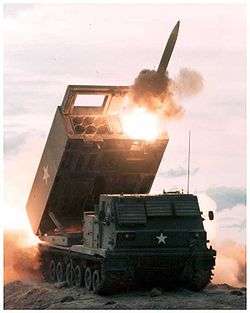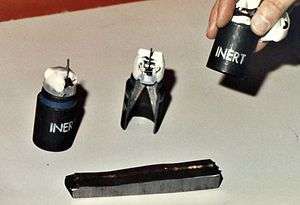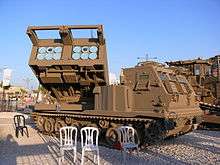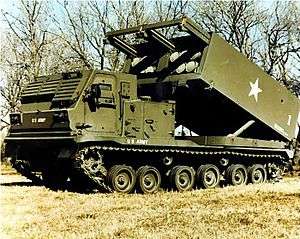M270 Multiple Launch Rocket System
| M270 Multiple Launch Rocket System (MLRS) | |
|---|---|
|
M270 MLRS | |
| Type | Multiple rocket launcher |
| Place of origin | United States |
| Service history | |
| In service | Since March 31, 1983 |
| Used by | See Operators |
| Wars |
Gulf War War in Afghanistan Iraq War |
| Production history | |
| Designer | Vought Corporation |
| Designed | 1977 |
| Manufacturer | Lockheed Martin, Diehl BGT Defence, Aérospatiale |
| Produced | 1980–2003 |
| Variants |
M270A1 M270B1 |
| Specifications | |
| Weight | 55,000 lb (24,950 kg) |
| Length | 22 ft 6 in (6.85 m) |
| Width | 9 ft 9 in (2.97 m) |
| Height | 8 ft 6 in (2.59 m) |
| Crew | 3 |
|
| |
| Rate of fire |
Rockets: 12 rounds in < 40 sec Missiles: 2 rounds in 10 sec |
| Effective firing range |
M26: 32 km (20 mi) M26A1/A2: 45 km (28 mi) M30/31: 84 km (52 mi) GMLRS+: 120 km (75 mi)[1][2][3] |
| Maximum firing range | ATACMS: 165 or 300 km (103 or 186 mi) |
|
| |
Main armament | M269 Launcher Loader Module |
| Engine |
Cummins Diesel 500 hp (368 kW) |
Operational range | 400 miles (640 km) |
| Speed | 40 mph (64.3 km/h) |
The M270 Multiple Launch Rocket System (M270 MLRS) is an armored, self-propelled, multiple rocket launcher; a type of rocket artillery.
Since the first M270s were delivered to the U.S. Army in 1983, the MLRS has been adopted by several NATO countries. Some 1,300 M270 systems have been manufactured in the United States and in Europe, along with more than 700,000 rockets. The production of the M270 ended in 2003, when a last batch was delivered to the Egyptian Army.
Overview
The weapon can fire guided and unguided projectiles up to 42 km (26 mi). Firing ballistic missiles, such as the U.S. Army Tactical Missile System (ATACMS), it can hit targets 300 km (190 mi) away; the warhead in such shots reaches an altitude of about 50 km (164,000 ft). The M270 can be used in shoot-and-scoot tactics, firing its rockets rapidly, then moving away to avoid counter-battery fire.
MLRS was developed jointly by the United Kingdom, United States, West Germany, France and Italy. It was developed from the older General Support Rocket System (GSRS). The M270 MLRS weapons system is collectively known as the M270 MLRS Self-propelled Loader/Launcher (SPLL). The SPLL is composed of three primary subsystems: the M269 Loader Launcher Module (LLM), which also houses the electronic Fire Control System, is mated to the M993 Carrier Vehicle. The M993 is a derivative of the Bradley Fighting Vehicle chassis.[4][5]
The rockets and ATACMS missiles are contained in interchangeable pods. Each pod contains six standard rockets or one guided ATACMS missile; the two types cannot be mixed. The LLM can hold two pods at a time, which are hand-loaded using an integrated winch system. All twelve rockets or two ATACMS missiles can be fired in under a minute. One launcher firing twelve rockets can completely blanket one square kilometer with submunitions. For this reason, the MLRS is sometimes referred to as the "Grid Square Removal System" (metric maps are usually divided up into 1 km grids).[6] A typical MLRS cluster salvo consisted of three M270 vehicles each firing all 12 rockets. With each rocket containing 644 M77 grenades, the entire salvo would drop 23,184 grenades in the target area. However, with a two percent dud rate, that would leave approximately 400 undetonated bombs scattered over the area, which would endanger friendly troops and civilians.[7]
In 2006, MLRS was upgraded to fire guided rounds. Phase I testing of a guided unitary round (XM31) was completed on an accelerated schedule in March 2006. Due to an Urgent Need Statement, the guided unitary round was quickly fielded and used in action in Iraq.[8] Lockheed Martin also received a contract to convert existing M30 DPICM GMLRS rockets to the XM31 unitary variant.[9]
The M31 GMLRS Unitary rocket transformed the M270 into a point target artillery system for the first time. Due to GPS guidance and a single 200 lb (91 kg) high-explosive warhead, the M31 could hit targets accurately with less chance of collateral damage while needing fewer rockets to be fired, reducing logistical requirements. The unitary warhead also made the MLRS able to be used in urban environments. The M31 had a dual-mode fuse with point detonation and delay options to defeat soft targets and lightly fortified bunkers respectively, with the upgraded M31A1 equipped with a multi-mode fuse adding a proximity airburst mode for use against personnel in the open; proximity mode can be set for 3 or 10 metres (9.8 or 32.8 ft) height of burst (HOB). The GMLRS has a minimum engagement range of 15 km (9.3 mi) and can hit a target out to 70 km (43 mi), impacting at a speed of Mach 2.5.[10][11]
A German developmental artillery system, called the Artillery Gun Module, has used the MLRS chassis on its developmental vehicles.[12]
In 2012, a contract was issued to improve the armor of the M270s and improve the fire control to the standards of the HIMARS.[13] In June 2015, the M270A1 conducted tests of firing rockets after upgrades from the Improved Armored Cab project, which provides the vehicle with an enhanced armored cab and windows.[14]
Service history

When first deployed with the U.S. Army, the MLRS was used in a composite battalion consisting of two batteries of traditional artillery (howitzers) and one battery of MLRS SPLLs (self-propelled loader/launchers). The first operational organic or "all MLRS" unit was 6th Battalion, 27th Field Artillery.[15]
The 6th Battalion, 27th Field Artillery was reactivated as the Army's first Multiple Launch Rocket System (MLRS) battalion on 1 October 1984, and became known as the "Proud Rockets". In March 1990, the unit deployed to White Sands Missile Range, New Mexico to conduct the Initial Operational Test and Evaluation of the Army Tactical Missile System. The success of the test provided the Army with a highly accurate, long range fire support asset.
On 2 September 1990, the 6th Battalion, 27th Field Artillery deployed to Saudi Arabia in support of Operation Desert Shield. Assigned to the XVIII Airborne Corps Artillery, the unit played a critical role in the early defense of Saudi Arabia. As Desert Shield turned into Desert Storm, the Battalion was the first U.S. Field Artillery unit to fire into Kuwait. Over the course of the war, the 6th Battalion, 27th Field Artillery provided timely and accurate rocket and missile fires for both U.S. corps in the theater, the 82nd Airborne Division, the 6th French Light Armored Division, the 1st Armored, 1st Infantry Division, the 101st Airborne Division, and the 24th Infantry Division (Mechanized).
A Battery 92nd Field Artillery (MLRS) was deployed to the Gulf War in 1990 from Ft.Hood Texas. 3/27th FA (MLRS) out of Fort Bragg deployed in support of Operation Desert Shield in August 1990. A/21st Field Artillery (MLRS) – 1st Cavalry Division Artillery deployed in support of Operation Desert Shield in September 1990. In December 1990, A-40th Field Artillery (MLRS) – 3rd Armored Division Artillery (Hanau), 1/27th FA (MLRS) part of the 41st Field Artillery Brigade (Babenhausen) and 4/27th FA (MLRS) (Wertheim) deployed in support of Operation Desert Shield from their bases in Germany and 1/158th Field Artillery from the Oklahoma Army National Guard deployed in January 1991.
In early February 1991, 1/27th FA launched the biggest MLRS night fire mission in history.[16] It has since been used in numerous military engagements, including the 2003 invasion of Iraq. In March 2007, the British Ministry of Defence decided to send a troop of MLRS to support ongoing operations in Afghanistan's southern province of Helmand; they will use newly developed guided munitions.
In April 2011, the first modernized MLRS II and M31 GMLRS rocket were handed over to the German Army's Artillery School in Idar Oberstein. The German Army operates the M31 rocket up to a range of 90 km.[17]
Versions
_Vehicles_at_Camp_Bastion%2C_Afghanistan_MOD_45148148.jpg)
(right vehicle)

_Bundeswehr.jpg)
- M270 is the original version, which carries a weapon load of 12 rockets in two six-pack launch pod containers. This armored, tracked mobile launcher uses a stretched Bradley chassis and has a high cross-country capability.
- M270 IPDS was an interim upgrade applied to a select number of launchers to provide the ability to fire the longer-range GPS-aided ATACMS Block IA, quick-reaction unitary and Block II missiles until sufficient M270A1 launchers were fielded.
- M270A1 was the result of an 2005 upgrade program for the U.S. Army, and later on for several other states. The launcher appears identical to M270, but incorporates an improved fire control system (IFCS) and an improved launcher mechanical system (ILMS). This allows for significantly faster launch procedures and the firing of new types of munitions, including GPS guided rockets.
- M270B1 is a British Army upgrade, similar to the A1, but it also includes an enhanced armor package, which gives the crew better protection against IED attacks.
MLRS rockets and missiles

The M270 system can fire MLRS Family Of Munition (MFOM) rockets and artillery missiles, which are manufactured and used by a number of platforms and countries. These include:
- M26 (United States): Rocket with 644 M77 Dual-Purpose Improved Conventional Munitions (DPICM) submunitions, range of 32 km.
- M26A1 (United States): Extended Range Rocket (ERR), with range of 45 km and 518 M85 submunitions (an improved version of the M77 DPICM submunition).
- M26A2 (United States): As M26A1, but using M77 submunitions. Interim use until M85 submunition entered service.
- M27 (United States): Completely inert training Launch Pod/Container to allow full loading cycle training.
- M28 (United States): Training rocket. M26 with three ballast containers and three smoke marking containers in place of submunition payload.
- M28A1 (United States): Reduced Range Practice Rocket (RRPR) with blunt nose. Range reduced to 9 km.
- XM29 (United States): Rocket with Sense and Destroy Armor (SADARM) submunitions. Not standardized.
- M30 (United States, Finland): Guided MLRS (GMLRS). A precision guided rocket, range over 60 km with a standard load of 404 M85 submunitions.
- M39 (MGM-140) (United States): Army Tactical Missile System (ATACMS). A large guided missile using the M270 launcher, with a variety of warheads. Main article: MGM-140 ATACMS
- XM135 (United States): Rocket with binary chemical warhead (VX (nerve agent)). Not standardized.
- Foreign rockets
- AT2 (Germany, UK, France): SCATMIN Rocket with 28 anti-tank mines and range of 38 km.
- PARS SAGE-227 F (Turkey): Experimental Guided MLRS (GMLRS) developed by TUBITAK-SAGE to replace the M26 rockets.
- Trajectory Corrected Rocket (TCS/RAMAM) (Israel): In-flight trajectory corrected for enhanced accuracy.
- Romah (Israel): GPS-guided rocket with 35 km (22 mi) range, 20 kg (44 lb) warhead, and accuracy of less than 10 meters.[20]
Selected rocket specifications
- Caliber: 227 mm (8.94 in)
- Length: 3.94 m (12.93 ft)
- Motor: Solid-fuel rocket
| Name | Weight | Range (max) | Guidance | Warhead |
|---|---|---|---|---|
| M26 | 306 kg (675 lb) | 32 km (20 mi) | 644 M77 DPICM submunitions | |
| M26A1/A2 | 296 kg (650 lb) | over 45 km (28 mi) | M26A1: 518 M85 DPICM submunitions M26A2: 518 M77 DPICM submunitions | |
| M30/M31 | 84 km (52 mi)[21] | GPS/INS | M30: 404 M85 DPICM submunitions M31: 90 kg (200 lb) unitary HE | |
| AT2 SCATMIN | 254 kg (561 lb) | 39 km (24 mi) | ||
| PARS SAGE-227 F | over 300 kg/160 kg | 70 km (43 mi) |
Alternative Warhead Program
In April 2012, Lockheed Martin received a $79.4 million contract to develop a GMLRS incorporating an Alliant Techsystems-designed alternative warhead to replace DPICM cluster warheads. The AW version is designed as a drop-in replacement with little modification needed to existing rockets. An Engineering and Manufacturing Development (EMD) program was to last 36 months, with the alternative warhead GMLRS expected to enter service in late 2016.[22] The AW warhead is a large airburst fragmentation warhead that explodes 30 ft (9.1 m) over a target area to disperse penetrating projectiles. Considerable damage is caused to a large area while leaving behind only solid metal penetrators and inert rocket fragments[23] from a 90 kg (200 lb) warhead containing approximately 160,000 preformed tungsten fragments.[24]
On 22 May 2013, Lockheed and ATK test fired a GMLRS rocket with a new cluster munition warhead developed under the Alternative Warhead Program (AWP), aimed at producing a drop-in replacement for DPICM bomblets in M30 guided rockets. It was fired by an M142 HIMARS and traveled 35 km (22 mi) before detonating. The AWP warhead will have equal or greater effect against materiel and personnel targets, while leaving no unexploded ordnance behind.[25]
On 23 October 2013, Lockheed conducted the third and final engineering development test flight of the GMLRS alternative warhead. Three rockets were fired from 17 kilometres (11 mi) away and destroyed their ground targets. The Alternative Warhead Program then moved to production qualification testing.[26] The fifth and final Production Qualification Test (PQT) for the AW GMLRS was conducted in April 2014, firing four rockets from a HIMARS at targets 65 kilometres (40 mi) away.[27]
On 28 July 2014, Lockheed successfully completed all Developmental Test/Operational Test (DT/OT) flight tests for the AW GMLRS. They were the first tests conducted with soldiers operating the fire control system, firing rockets at mid and long-range from a HIMARS. The Initial Operational Test and Evaluation (IOT&E) exercise was to be conducted in fall 2014.[28]
On 15 September 2015, Lockheed received a contract for Lot 10 production of the GMLRS unitary rocket, which includes the first order for AW production.[29]
M993 Launcher specifications

- Entered service: 1982 (U.S. Army)
- First used in action: 1991 (First Gulf War)
- Crew: 3
- Weight loaded: 24,756 kg
- Length: 6.86 metres (22 ft 6 in)
- Width: 2.97 metres (9 ft 9 in)[30]
- Height (stowed): 2.57 m (8 ft 5 in)[31]
- Height (max elevation): not available
- Max road speed: 64 km/h
- Cruise range: 480 km
- Reload time: 4 min (M270) 3 min (M270A1)
- Engine: Turbo-charged V8 Cummins VTA903 diesel 500 hp ver2.
- Crossdrive turbo transmission fully electronically controlled
- Average unit cost: $2.3 million[4]
Operators

Current operators
 Egypt: Egyptian Army (48)
Egypt: Egyptian Army (48) Bahrain: Royal Bahraini Army (9), ATACMS operational.[32]
Bahrain: Royal Bahraini Army (9), ATACMS operational.[32] Finland: Finnish Army (22[33]), called 298 RsRakH 06. Upgraded to enable GMLRS and ATACMS,[33] the rest (12 former Danish M270A1) are used for driver training only.[34]
Finland: Finnish Army (22[33]), called 298 RsRakH 06. Upgraded to enable GMLRS and ATACMS,[33] the rest (12 former Danish M270A1) are used for driver training only.[34] France: French Army (13[35]), called LRU Lance-Roquette Unitaire.[35] Upgraded to GMLRS standard.[36]
France: French Army (13[35]), called LRU Lance-Roquette Unitaire.[35] Upgraded to GMLRS standard.[36] Germany: German Army (50+202), called MARS II[37] Mittleres Artillerie Raketen System. Upgraded to GMLRS standard.[36]
Germany: German Army (50+202), called MARS II[37] Mittleres Artillerie Raketen System. Upgraded to GMLRS standard.[36] Greece: Hellenic Army (36) ATACMS operational.[32]
Greece: Hellenic Army (36) ATACMS operational.[32] Israel: Israel Defense Forces (64), called "Menatetz" מנתץ, "Smasher"[38]
Israel: Israel Defense Forces (64), called "Menatetz" מנתץ, "Smasher"[38] Italy: Italian Army (22), called MLRS improved.[37] Upgraded to GMLRS standard.[36]
Italy: Italian Army (22), called MLRS improved.[37] Upgraded to GMLRS standard.[36] Japan: Japan Ground Self-Defense Force (99). GMLRS and ATACMS operational.[32][39]
Japan: Japan Ground Self-Defense Force (99). GMLRS and ATACMS operational.[32][39] Saudi Arabia: Armed Forces of Saudi Arabia (50) Royal Saudi Land Force Royal Artillery Corps
Saudi Arabia: Armed Forces of Saudi Arabia (50) Royal Saudi Land Force Royal Artillery Corps South Korea: Republic of Korea Army (58) 48 M270s and 10 M270A1s. ATACMS operational.[32][40][41]
South Korea: Republic of Korea Army (58) 48 M270s and 10 M270A1s. ATACMS operational.[32][40][41] Turkey: Turkish Army (12)
Turkey: Turkish Army (12) United Kingdom: Royal Artillery (42), upgraded to M270B1, which is A1 + enhanced armor package.[42] GLMRS operational.[42]
United Kingdom: Royal Artillery (42), upgraded to M270B1, which is A1 + enhanced armor package.[42] GLMRS operational.[42] United States: United States Army (840+151), 220+ upgraded to M270A1.[42] GLMRS and ATACMS operational.[42]
United States: United States Army (840+151), 220+ upgraded to M270A1.[42] GLMRS and ATACMS operational.[42]
Former operators
 Denmark: Royal Danish Army (no longer in service; sold to Finnish Army) (12)
Denmark: Royal Danish Army (no longer in service; sold to Finnish Army) (12) Netherlands: Royal Netherlands Army (out of service since 2004; sold to Finnish Army)
Netherlands: Royal Netherlands Army (out of service since 2004; sold to Finnish Army) Norway: Norwegian Army (12) (never entered active service. In storage)
Norway: Norwegian Army (12) (never entered active service. In storage)
Nicknames
US military operators refer to the M270 as "the commander's personal shotgun" or as "battlefield buckshot". It is also commonly referred to as the "Gypsy Wagon", because crews store additional equipment, such as camouflage netting, cots, coolers, and personal items, on top of the vehicle as the launcher itself lacks adequate storage space for the crew. Within the British military, a common nickname is "Grid Square Removal System", a play on the initialism GSRS (from the older General Support Rocket System). With the adoption of the new M30 GPS guided rocket, it is now being referred to as the "70 kilometer sniper rifle".[43] During the 1991 Gulf War, the Iraqis referred to the small M77 submunitions rockets as the "Steel Rain".
See also
References
- ↑ https://www.youtube.com/watch?v=SjzvNo7bmt0
- ↑ Lockheed Martin receives MLRS follow-on order - Shephardmedia.com, 20 July 2012
- ↑ Additional GMLRS rockets ordered by US Army from Lockheed - Army-Technology.com, 4 February 2013
- 1 2 John Pike. "M270 Multiple Launch Rocket System - MLRS". Globalsecurity.org. Retrieved 2013-10-23.
- ↑ "M270 Multiple Launch Rocket System - MLRS". Fas.org. Retrieved 2013-10-23.
- ↑ Ben Rooney, "Tank-busting helicopters ready for action", Daily Telegraph, April 21, 1999.
- ↑ After Cluster Bombs: Raining Nails - Wired.com, 30 May 2008
- ↑ "Guided MLRS Unitary Rocket Successfully Tested", Microwave Journal, Vol. 49, No. 3 (March 2006), page 39.
- ↑ "Lockheed Gets $16.6M to Convert MLRS Rockets, Asked to Speed Up GMLRS Production (updated)". Defense Industry Daily. August 2, 2006. Retrieved 2013-10-23.
- ↑ M31 GMLRS Unitary - Globalsecurity.org
- ↑ Precision Fires Rocket & Missile Systems - MSL.Army.mil
- ↑ "Defense & Security Intelligence & Analysis: IHS Jane's | IHS". Janes.com. Retrieved 2013-10-23.
- ↑ "USA Moves to Update Its M270 Rocket Launchers". Defenseindustrydaily.com. 2012-07-01. Retrieved 2013-10-23.
- ↑ Improved Multiple Launch Rocket System tested at White Sands Missile Range - Army.mil, 31 July 2015
- ↑ "History for 6th Battalion, 27th Field Artillery (1960s to Present)". Military.com. Retrieved 2013-10-23.
- ↑ "C-1/27th FA MLRS". YouTube. 2009-11-26. Retrieved 2013-10-23.
- ↑ "Rollout MARS II und GMLRS Unitary" (in German). Bwb.org. 2012-07-26. Retrieved 2012-08-06.
- ↑ http://www.lockheedmartin.com/us/products/GuidedUnitaryMLRSRocket.html
- ↑ http://www.dsca.mil/major-arms-sales/finland-guided-multiple-launch-rocket-system-gmlrs-m31a1-unitary-and-gmlrs-m30a1
- ↑ Israel's new guided missiles system Romah will soon be operational - Armyrecognition.com, 15 January 2016
- ↑ (French) Fabrice Fayet, Détachement de Liaison, Observation et Coordination, p. 15, Joint Centre of concepts, doctrines and experiments, French army, 8 june 2015
- ↑ GMLRS to Get a New Warhead - Defense-Update.com, 24 April 2012
- ↑ Army tests safer warhead - Armytechnology.Armylive.DoDlive.mil, 2 September 2014
- ↑ Guided Multiple Launch Rocket System (GMLRS) Alternative Warhead (GMLRS-AW) XM30A1 - Office of the Director, Operational Test & Evaluation. 2014
- ↑ "US Army searches for cluster munitions alternatives". Dmilt.com. Retrieved 2013-10-23.
- ↑ Alternative GMLRS Warhead Completes Third Successful Fight Test - Deagel.com, 23 October 2013
- ↑ Lockheed Martin GMLRS Alternative Warhead Logs Successful Flight-Test Series, Shifts To Next Testing Phase - Lockheed news release, 16 April 2014
- ↑ Lockheed Martin Completes Successful Operational Flight Tests of GMLRS Alternative Warhead - Deagel.com, 28 July 2014
- ↑ Lockheed Martin GMLRS Alternative Warhead Gets First Order - Marketwatch.com, 15 September 2015
- ↑ Archived March 9, 2008, at the Wayback Machine.
- ↑ Archived August 23, 2004, at the Wayback Machine.
- 1 2 3 4 "Atacms". Deagel.com. Retrieved 2 June 2015.
- 1 2 "Lockheed Martin Receives $45.3 Million Contract to Upgrade Finland's Precision Fires Capability". PR Newswire. Lockheed Martin. 18 May 2011. Retrieved 2 June 2015.
- ↑ "M270 (MLRS)". Armyvehicles.dk. 2014. Retrieved 2 June 2015.
- 1 2 "La DGA commande 13 Lance-roquettes unitaires (LRU)". Defense.gouv.fr. Direction générale de l'armement. 7 Oct 2011. Retrieved 2 June 2015.
- 1 2 3 "Sagem's Sigma 30 navigation and pointing system chosen to modernize M270 Multiple Launch Rocket Systems for three European armies". Safran. Sagem. 18 Jan 2012. Retrieved 2 June 2015.
- 1 2 "MLRS Improved". Krauss-Maffei Wegmann. Retrieved 2 June 2015.
- ↑ Institute, Stockholm. "Trade Registers". sipri. Stockholm International Peace Research Institute. Retrieved 13 August 2016.
- ↑ "GMLRS" (PDF). Lockheed Martin. Retrieved 2 June 2015.
- ↑ "M270 MLRS Report between 1993 and 2014". Deagel.com. Retrieved 29 August 2016.
- ↑ "MLRS (Multiple Launch Rocket System), United States of America". army-technology.com. Retrieved 29 August 2016.
- 1 2 3 4 "MLRS® M270 Series Launchers" (PDF). Lockheed Martin. Retrieved 2 June 2015.
- ↑ Archived December 23, 2009, at the Wayback Machine.
External links
| Wikimedia Commons has media related to Multiple Launch Rocket System. |
- British MLRS
- Designation Systems
- Diehl BGT—German developer and manufacturer of GMLRS (site in English)
- Danish M270 MLRS

